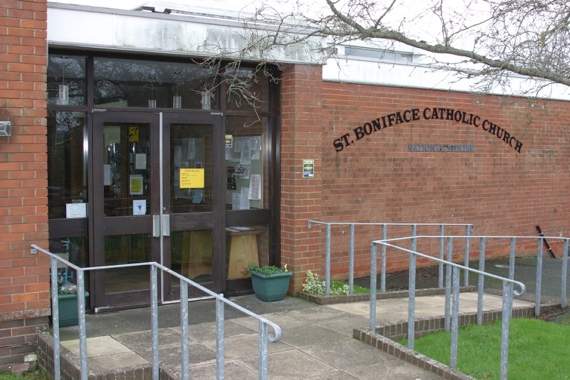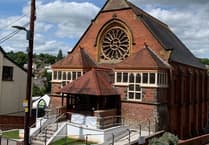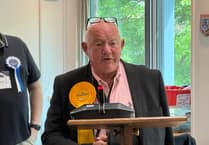Exclusive by Alan Quick
THE National Shrine to the Saxon saint and missionary, Boniface, who was born in Crediton in 680AD, is to be extensively refurbished.
St Boniface, who was born and christened Wynfrith or Winfrith (or Winfrid), grew to become a major figure in the Roman Catholic Church and continues to be celebrated today as the “Apostle of Germany” and the first archbishop of Mainz.
His missionary work in the German parts of the Frankish empire is widely commemorated.
This included the symbolic felling of Thor’s Oak, which converted many pagans to Christianity, and his recognition as the creator of the first ever Christmas tree.
The National Shrine to Crediton’s most famous son is in the Roman Catholic Church in Park Road, Crediton.
News of the planned refurbishment of the Shrine of St Boniface in the Church was recently announced to the congregation at the church by Father Michael Wheaton, Catholic Chaplain, Exeter University, the Priest-in-Charge responsible for Crediton.
Talking exclusively to the "Crediton Courier", Father Michael, said: "A couple of years ago a new bishop arrived in the diocese (Mgr. Mark O’Toole, Bishop of Plymouth - covering all of Devon, Dorset and Cornwall) and he cast fresh eyes on our churches throughout the South West (the previous bishop had been with us since 1986; and his predecessor had been here since 1954).
UNDERWHELMING
"When he saw the shrine he observed that it looked a bit tired and underwhelming, particularly in view of the fact that many pilgrims travel here overland from central and southern Germany.
"When I was serving in Exeter, one German priest said to me: ’I have come to England to see just two things: Stonehenge and the Shrine of St Boniface at Crediton’.
"The basic problem is that many of our pilgrims assume they are coming to something like Buckfast Abbey, but they arrive only to find a little 1960’s brick church."
Father Michael said that the Bishop suggested the following improvements:
1. To pave the shrine corridor in stone slabs, some inscribed with place names important in the life of St Boniface (e.g. Crediton, Exeter, Nursling, Dokkam, Mainz, Fulda, Geismar, etc). This will help create a sense of movement from the main door to the shrine.
2. To pave the floor of the shrine with stone slabs, allowing the installation of votive candle stands (currently the shrine is carpeted). This will give pilgrims the opportunity to light candles.
3. To clad the walls of the shrine in marble.
4. To install a five foot statue of St Boniface. (The church has already acquired the statue - it came from Holland - it dates to the 19th Century and is polychrome on terracotta).
5. To display more clearly the relic (This is a bone, believed to be a bone from the finger of St Boniface which was given to the National Shrine some years ago by the Bishop of Fulda, where the body of St Boniface is interred). This will be located in a niche at the front of the plinth on which the statue will stand.
Father Michael added: "We hope to complete this refurbishment by the Spring of 2016.
"On June 5, the Feast of St Boniface, Mgr Mark O’Toole will lead the Plymouth Diocesan Pilgrimage to Crediton and he will hopefully be able to bless and re-dedicate the shrine."
It is believed that funding for the refurbishment would come from the Roman Catholic Church nationally or from the Roman Catholic Church internationally.
HISTORY
Crediton’s history is strongly based on Winfrith, who later became one of the greatest Christian missionaries and administrators, and one of the founding fathers of the Christian Church in Europe.
St Boniface is the patron saint of both Germany and the Netherlands.
Crediton’s most famous building is the Parish Church of the Holy Cross. The history of the church and religion in Crediton dates back hundreds of years.
Boniface links with Crediton led to the founding of a monastery in the town in 739 which in turn is believed to have led to the choice of Crediton as the See of the first bishopric of Devon and the building in 909 of the first diocesan church in the town.
The current collegiate church was completed around 1410. There are many references to St Boniface in Crediton Parish Church including stained glass window representations and an effigy by Witold Kawalec.
The area of the town known as Tolleys is regarded as the traditional birthplace of St Boniface and a blue plaque marking this can be seen at the corner of Tolleys and Downshead Lane.
An impressive statue of St Boniface is located in Newcombes Meadow, Crediton.
It was unveiled by Princess Margaret on Sunday, July 24, 1960 and the dedication was by the then Bishop of Crediton, Wilfrid Westall.
CHRISTMAS TREE
How St Boniface came to be acknowledged for starting the tradition of the Christmas tree is surrounded with some myth.
In the dramatised story about Boniface by Henry Van Dyke, “The First Christmas Tree” (1897), it states: “Armed with an axe he approached a sacred tree, the giant oak of Geismar, dedicated to Thor.
“After some effort, he felled the oak, and its branches lay on the ground in the shape of a cross. In its descent, sections of the oak had crushed every other tree around except a single small fir tree (this was possibly the origin of the Christmas tree).”
Other stories say that a fir tree grew from the roots of the fallen oak and the next year after he had felled it, all the pagans in the area had been converted to Christianity and hung decorations from the tree to celebrate what they now called Christmas rather than Winter Solstice.
Many will wonder how a fir tree grew big enough to decorate in one year.
The fir was seen as an image of God and many believed its evergreen symbolised the everlasting love of the Maker.
Whichever it was, the legend spread and soon Christmas trees became the norm in the newly converted Bavaria, and then spread out to become the tinsel strewn, electric lit, bauble hung festival we know today, popularised by Queen Victoria’s consort Albert, who brought the tradition of Christmas trees to England from Germany.
COACH PARK
Mid Devon District Council, with the support of Crediton Town Council, aware of the large numbers of visitors travelling to the town to visit the birthplace of Saint Boniface, recently proposed that a coach park be installed in the town centre where coaches of visitors would be able to get off and on a coach during their visit.
Paul Tucker from MDDC said: "What we’d like to find is either a place to park a coach within the town centre that will give passengers easy access to the town centre or a dropping off point in the town centre for passengers and somewhere close by for the coach to retire to until pick-up time."
Mr Tucker has written to individuals and organisations in the town in an effort to locate suitable sites for coach parking, indicating that such centrally located coach parks could benefit local traders.
’THE GREATEST ENGLISHMAN’
St Boniface had an enormous impact on English and European history, far beyond the simple conversion of people to Christianity. His guidance of the early church in Germany, his establishment of structures which allowed it to co-exist with monarchy, were massively important, and the educational and literary influence from his monasteries and churches in his lifetime and over the next centuries was very significant.
He has been described by eminent historians as “The greatest Englishman of all time” and “the Englishman who has had a greater influence on the history of Europe than any other Englishman”, but in England he is not so greatly known.
At one time there was a move to have him made the Patron Saint of all Europe.

.jpg?width=209&height=140&crop=209:145,smart&quality=75)



Comments
This article has no comments yet. Be the first to leave a comment.